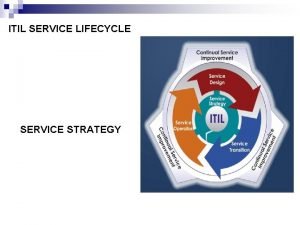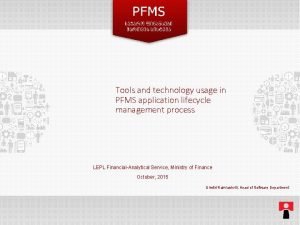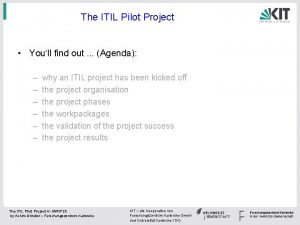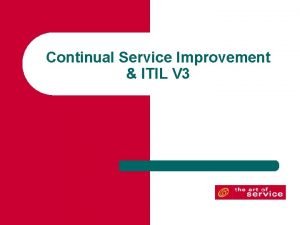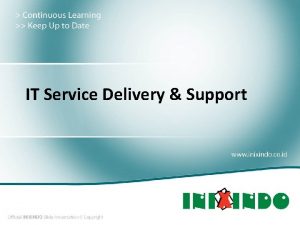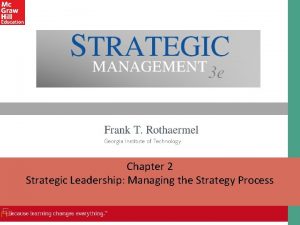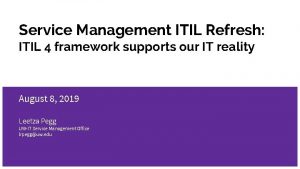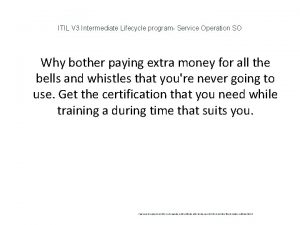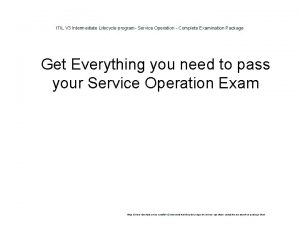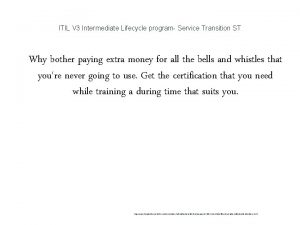ITIL SERVICE LIFECYCLE SERVICE STRATEGY ITIL LIFECYCLE STAGES














- Slides: 14

ITIL SERVICE LIFECYCLE SERVICE STRATEGY

ITIL LIFECYCLE – STAGES – SERVICE STRATEGY Service Strategy is the first phase of the ITIL Service Management Lifecycle. It is the axis around which the lifecycle rotates. This phase is used to establish an overall strategy for the organization’s planned IT services and IT service management (ITSM) practices. It culminates in a strategic plan that specifies how the organization’s planned IT services and ITSM policies and processes will be used to achieve defined objectives. Service Strategy is also about establishment and management of the broadest policies and standards which govern the way a Service Provider operates.

ITIL LIFECYCLE – STAGES – SERVICE STRATEGY The Service Strategy phase helps ensure that the organization is prepared to manage the costs and risks associated with initiating any new services. Within this phase, organizations perform the following: Define the market space for the planned IT services Set performance expectations for serving customers Identify, prioritize, and select opportunities Develop the policies, guidelines, and processes that will be used to manage the IT services

ITIL LIFECYCLE – STAGES – SERVICE STRATEGY The Service Strategy phase has 5 processes: Strategy Management for IT Services Service Portfolio Management Financial Management for IT Services Demand Management Business Relationship Management

SERVICE STRATEGY – STRATEGY MANAGEMENT Strategy management process is used to develop the organization’s overall strategy for IT services and IT Service Management. It results in a plan designed to achieve the business objectives. Process Objective: To assess the service provider's offerings, capabilities, competitors as well as current and potential market spaces in order to develop a strategy to serve customers. Once the strategy has been defined, Strategy Management for IT Services is also responsible for ensuring the implementation of the strategy.

SERVICE STRATEGY – STRATEGY MANAGEMENT Activities within this process include: 1. Understand the market a. Who is the customer? b. What do they value? c. How do they define value? 2. Develop the offerings a. What service offerings would provide value to customers as defined above? b. How can we as a service provider offer unique or distinctive value? 3. Develop strategic assets a. What resources would be required to offer the services identified? b. What capabilities would be need to offer the services identified? 4. Prepare for execution a. How can we prepare to build or develop the service? b. What are our specific objectives for the service? c. What specific critical success factors must we meet in order to achieve those objectives?

SERVICE STRATEGY – FINANCIAL MANAGEMENT Financial Management quantifies the value of a service and its underlying assets and establishes the operational financial forecasts (budget) for the service. Financial Management seeks to ensure that the business understands the costs of providing a service and knows how to manage these costs. This process implements IT accounting, budgeting, and charging processes for services, by allocating IT expenditures to services and by recovering the costs from customers to whom the services are provided.

SERVICE STRATEGY- SERVICE PORTFOLIO MANAGEMENT The Service Portfolio is the core repository for all information for all services in an organization. It contains present contractual commitments, new service development, and ongoing service improvement plans initiated by Continual Service Improvement. It also includes third-party services which are an integral part of service offerings to customers. The Service Portfolio consists of three parts: Service Pipeline: This contains references to services that are not yet live. They may be proposed, or under development Service Catalogue: This contains links to active services. Retired Services: Services in the process of being discontinued, before they are finally decommissioned Of these three, only the Service Catalogue is visible to the customers and support team. Customers are excluded from the pipeline provisioning process for services under development

SERVICE STRATEGY- SERVICE PORTFOLIO MANAGEMENT The main task of the Service portfolio management process is to provide a set of tools for assessing and approval of new or changed services, and to manage the IT services throughout their lifecycles. The objectives of SPM are: • To develop and maintain a Service Portfolio that provides a complete picture of all services including their status • To establish conditions and requirements for inclusion of new services in the Service Portfolio • To ensure a Service Catalogue is developed and managed as part of the Portfolio, • Agree on the rules for transferring services to the Service Catalogue as they move into Transition and out of the Catalogue and as they move into retirement • To ensure that the Service Portfolio meets the functional and performance requirements of its users and that its performance, availability and security meet agreed requirements • To ensure that management reports are produced in line with agreed reporting requirements.

SERVICE STRATEGY – DEMAND MANAGEMENT Demand management is a critical aspect of service management. Poorly managed demand is a source of risk for service providers because of uncertainty in demand. Excess capacity generates cost without creating value that provides a basis for cost recovery. The purpose of Demand Management is to understand influence customer demand for services and the provision of capacity to meet these demands. At a strategic level this can involve analysis of patterns of business activity and user profiles. At a tactical level it can involve use of differential charging to encourage customers to use IT services at less busy times.

SERVICE STRATEGY – BUSINESS RELATIONSHIP MANAGEMENT Business Relationship Management aims to maintain a positive relationship with customers. ITIL Business Relationship Management identifies the needs of existing and potential customers and ensures that appropriate services are developed to meet those needs.

SERVICE STRATEGY – BUSINESS RELATIONSHIP MANAGEMENT These are the Business Relationship Management sub-processes and their process objectives: Maintain Customer Relationships Process Objective: To ensure that the service provider continues to understand the needs of existing customers and establishes relationships with potential new customers. This process is also responsible for maintaining the Customer Portfolio. Identify Service Requirements Process Objective: To understand document the desired outcome of a service, and to decide if the customer's need can be fulfilled using an existing service offering or if a new or changed service must be created.

SERVICE STRATEGY – BUSINESS RELATIONSHIP MANAGEMENT Sign up Customers to Standard Services Process Objective: To capture customer requirements and agree service level targets with customers who request the provision of existing standard services (no modifications to existing Supporting Services are necessary in order to fulfill the customer's needs). Customer Satisfaction Survey Process Objective: To plan, carry out and evaluate regular customer satisfaction surveys. The principal aim of this process is to learn about areas where customer expectations are not being met before customers are lost to alternative service providers.

SERVICE STRATEGY – BUSINESS RELATIONSHIP MANAGEMENT Handle Customer Complaints Process Objective: To record customer complaints and compliments, to assess the complaints and to instigate corrective action if required. Monitor Customer Complaints Process Objective: To continuously monitor the processing status of outstanding customer complaints and to take corrective action if required.
 Itil 5 stages service lifecycle
Itil 5 stages service lifecycle Itil service transition definition
Itil service transition definition Itil 7 step continuous improvement process
Itil 7 step continuous improvement process Itil service lifecycle
Itil service lifecycle What are the 5 stages of the service lifecycle
What are the 5 stages of the service lifecycle Https://www.servicetonic.es/service-desk/que-es-un-sla/
Https://www.servicetonic.es/service-desk/que-es-un-sla/ Application lifecycle management itil
Application lifecycle management itil What are the 5 stages of itil?
What are the 5 stages of itil? Continual service improvement metrics itil
Continual service improvement metrics itil It service delivery and support
It service delivery and support Afi framework example
Afi framework example Wave soa
Wave soa Corporate strategy and business strategy
Corporate strategy and business strategy Global matrix structure
Global matrix structure Example of chase strategy
Example of chase strategy
